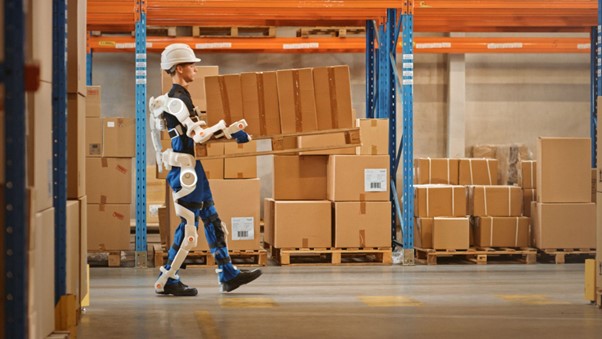Consumption habits and the need to quickly meet demand have led companies to change their operating processes and to consider more relevantly new technological integrations, in order to optimize their supply chain and satisfy the market in a timely manner.

Automation investments in retail companies are ready to fuel powerful growth in the industry, with the global warehouse automation market expected to hit $51 billion by 2030, according to a McKinsey study.
Starting from this, we have analyzed one of the most relevant advances: Wearable Robotics. These are tools that help warehouse operators to carry out their work autonomously and efficiently, as well as improve ergonomics and safety.
Stay and discuss with us why Wearable Robotics are so essential in logistics today and how they will optimize your operation.
¿What are Wearable Robotics?
When we refer to Wearable Robotics, we are talking about robotic devices that fit the human body, their objective is to facilitate the movements of the operator to fulfill their daily tasks, allowing them to have their hands free, which provides many operational advantages and increases productivity.
According to a Supply Chain report it is expected that by 2025, 60% of companies will use at least five wireless technologies in paralle, this ensures the demand and relevance of wearables within the processes, since these will be fundamental to streamline and optimize the operation.
We can find various wearable devices, from tools that go on the hand and wrist, to the face, or that have full body coverage. We are going to know some devices that we find in the logistics industry:
Ring scanner: According to infobae, this device is one of the main ones used in wineries worldwide. The Ring scanner has a reader mechanism and its wear as a ring; the workers are in charge of scanning the products and loads. Helps optimize high-volume flows for picking, storage, and packaging processes.
Smart glove: Using gloves eliminates the need to bring portable tools to scan products, reaching up to 50% more efficiency. It is a technology that allows operators to be hand- free for greater comfort; They are able to classify items and help prevent employees from moving forward or moving when there is a latent threat.
They are usually lightweight tools and offer significant flexibility, as well as reducing errors to 0%.
Exoskeletons and sensors: They are structures that help operators load heavy things more easily and without risk. It can be described as a frame with joints, which facilitates movement and increases productivity. According to Claudia Roa, Global President of DHL's Pharmaceutical and Medical Equipment Sector, wearables are used in North America to correct the posture of operators.
On the other hand, Jim Miller, Vice President of Defense Solutions, Sarcos Robotics, mentions that “among the markets where the most immediate need for full-body exoskeleton technology is seen are the automotive industry, aviation, industrial manufacturing, the oil and gas, energy, construction, and logistics. Full-body exoskeletons will revolutionize the workforce of the future by producing robots that enhance human performance by combining human intelligence, instinct, and judgment with machine strength, endurance, and precision, to deliver greater safety and productivity on the job. an endless number of environments in which automation is not possible.”
Smart glasses Normally they show the indications that the operator must follow, to have greater efficiency and accuracy in their tasks. They have augmented reality that facilitates these processes.
They are ideal for the logistics industry, especially in the precision of warehouse management and the efficiency in the preparation of orders since the commands by gestures or by voice offer remarkable competitive advantages.
As you can see, Wearable Robotics can be used a lot, and if we combine them with WMS, incredibly positive results will be achieved. Warehouse management systems (WMS) allow optimal inventory control, in addition to increasing productivity, competitiveness, as well as interconnection with other systems. One example is DHL, which pushed up to 1,000 Locus Robotics AMRs with the goal of deploying up to 2,000 robots by 2022.
¿What are the benefits of Wearable Robotics in the logistics operation?
Wearable Robotics make tasks easier, transforming operations in an agile and efficient way. Some advantages that Wearable Robotics offer within the supply chain are:
1. Operator errors are reduced. Operator control under a robotic wearable system provides comprehensive improvements. These technologies can provide from ergonomic support to control with predetermined software.
2. Increase productivity Having device synchronization allows easy handling of all stages of the operation, thus favoring the tasks of the operators, helping to reduce long transfer times and eradicate manual errors.
3. Higher control and efficiency. Technologies involved in Wearable Robotics such as Artificial Intelligence (AI), the Industrial Internet of Things (IoT), and Blockchain simplify operation.
4. Generate data. By integrating wearables into the operation, data collection is guaranteed, which allows for specific productivity analyzes, operational stoppages, or processes that require more focus.
Technology within the logistics industry is evolving rapidly, and we can already see many of these wearables within the environment, as is the case of ProGlove, which participates in the automotive, manufacturing and logistics sectors, where it has helped to eliminate the use of handhelds.
To stay at the forefront, it is necessary to evaluate and invest in solutions such as those described above, to improve not only the productivity of your warehouse, but also the safety of your operators. Investment in infrastructure, as well as improvements and innovation, achieves ROI in a short time, so it is worth maintaining an open ideology and embracing technological progress.
When your collaborators are safe and work in a technological environment, their perception of value for the operation grows!
Posted by: G.I.Eicom
Leaders in Material Handling & Intralogistics Solutions